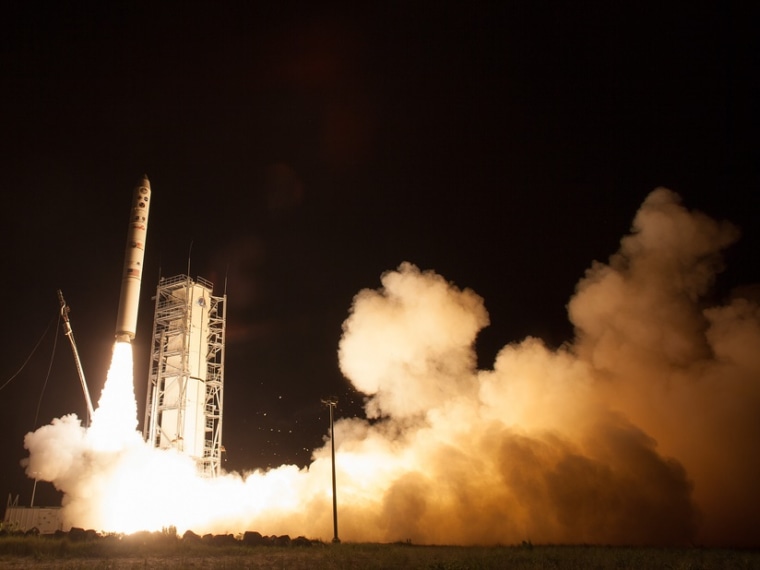A new kind of rocket that was assembled from ICBMs launched a NASA spacecraft on the first leg of its trip to lunar orbit on Friday — and lit up the skies over the U.S. East Coast in the process.
NASA's Lunar Atmosphere and Dust Environment Explorer, or LADEE, rose from its coastal launch pad in Virginia atop a five-stage Minotaur 5 rocket right on schedule, at 11:27 p.m. ET. The rocket's red glare was potentially visible from a swath of the Eastern Seaboard ranging from South Carolina to Maine.
The launch marked the debut of Orbital Sciences Corp.'s Minotaur 5, which incorporates components from decommissioned Peacekeeper missiles. It marked the first lunar mission to originate from the Mid-Atlantic Regional Spaceport at NASA's Wallops Flight Facility in Virginia. And it marked the last moon launch on NASA's schedule.
This was only the second time that a U.S. moon shot lifted off from anyplace other than Florida: The other occasion was the Clementine orbiter's launch from California's Vandenberg Air Force Base in 1994. Wallops was chosen for LADEE's launch in part because it's one of the few spaceports cleared to use Peacekeeper components under the terms of U.S.-Russian arms treaties.
Glitch crops up in orbit
John Grunsfeld, associate administrator for NASA's science mission directorate, told reporters after the launch that the spacecraft was "doing fine," but that there was a glitch involving the reaction wheels that are used to stabilize its spin in orbit.
When the wheels were activated, LADEE's onboard computer immediately shut them down, apparently due to excessive current, said Pete Worden, director of NASA's Ames Research Center in California. Ames built the spacecraft and manages the LADEE mission.
"We hope in the next few days to get these bugs ironed out and get the science that we expect," Worden said. He estimated that the mission team had 15 to 20 days to determine what action needed to be taken.
Studying atmosphere and dust
LADEE (pronounced like "laddie") is designed to study the moon's nearly non-existent atmosphere, molecule by molecule, and track the dust wafting up from the lunar surface. The mission was timed to take readings in advance of what may turn into a wave of dust-disturbing moon landings, including a Chinese mission that may head for the lunar surface later this year.
The $280 million mission may well resolve a decades-old mystery surrounding the Apollo astronauts' sightings of a faint glow on the lunar horizon before sunrise. Scientists suspect the glow comes from a haze of dust, rising up from the surface to be illuminated by sunlight. Exactly what makes it rise? LADEE could find the answer.

That fine dust could pose a challenge if and when humans return to the moon — in fact, the mission was conceived during a time when NASA was considering setting up permanent lunar bases. Those plans have been put aside, but scientists say the insights gained by LADEE could help them understand other potentially dusty environments, ranging from the planet Mercury to asteroids.
LADEE is breaking new technological ground as well. "It represents a new step in building spacecraft," Worden said. The car-sized, 844-pound probe is the first in what's expected to be a series of modular spacecraft that could be adapted for use on the moon, on Mars or other interplanetary destinations.
In addition to its science instruments, LADEE is carrying an experimental laser communication device that could send data back to Earth six times faster than the radio-based method that's currently used. If the system works as NASA hopes, it could be built into future spacecraft.
It'll take about a month for LADEE to go through a complicated series of maneuvers that will get it to lunar orbit, and another month to get ready for scientific observations. After its 100-day science mission is complete, the spacecraft will be guided to a crash landing — an impact that should send up a spectacular spray of moon dust.
More about LADEE:
- Probe packs a space laser for high-tech test
- LADEE aims to solve 50-year-old mystery
- Does the moon have levitating dust?
Alan Boyle is NBCNews.com's science editor. Connect with the Cosmic Log community by "liking" the NBC News Science Facebook page, following @b0yle on Twitter and adding +Alan Boyle to your Google+ circles. To keep up with NBCNews.com's stories about science and space, sign up for the Tech & Science newsletter, delivered to your email in-box every weekday. You can also check out "The Case for Pluto," my book about the controversial dwarf planet and the search for new worlds.
